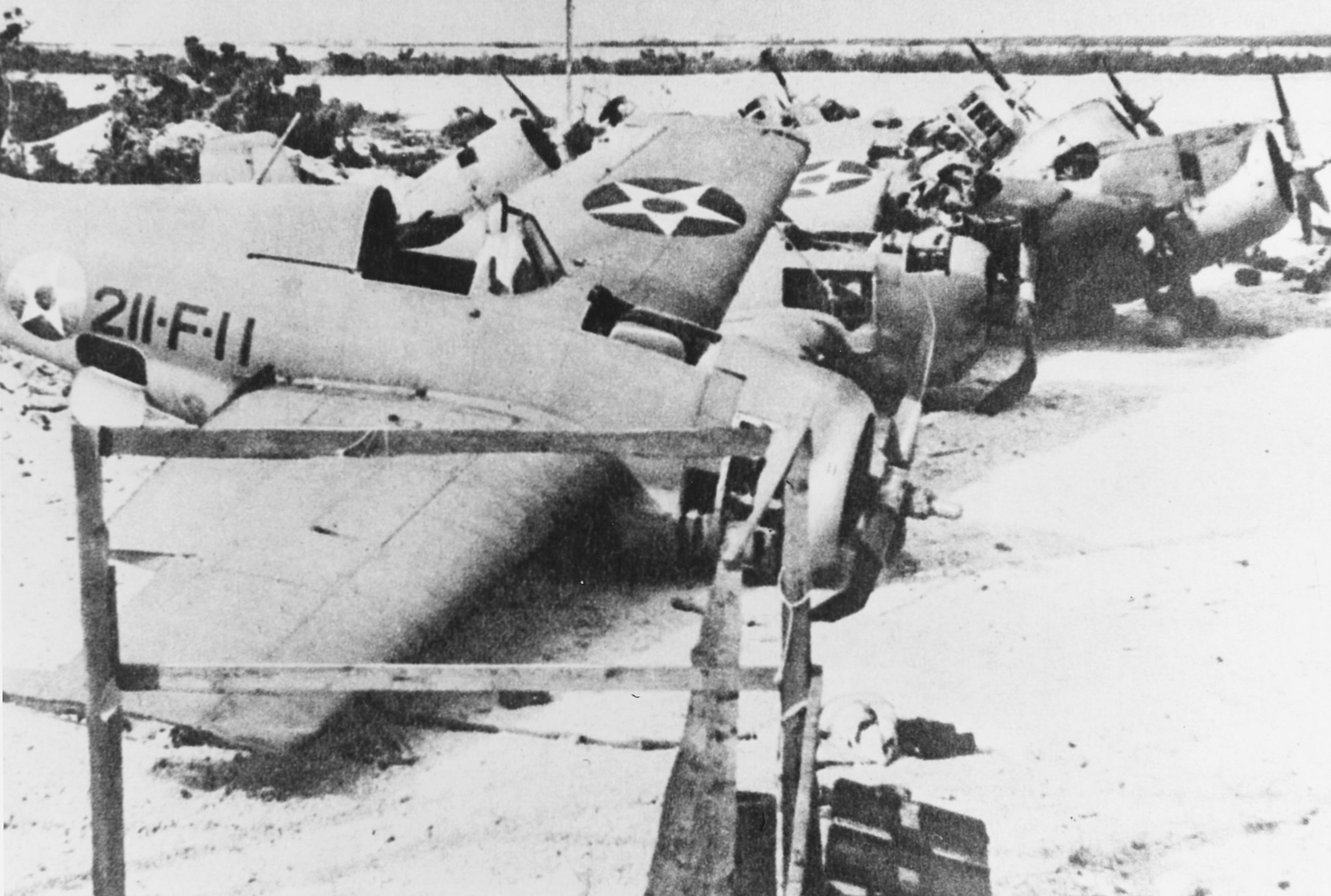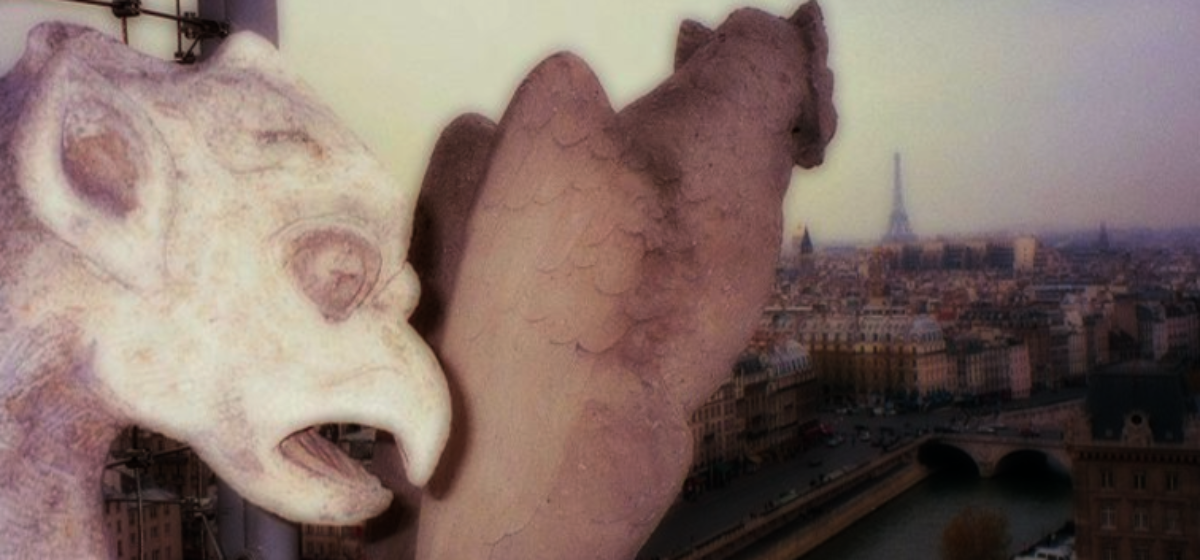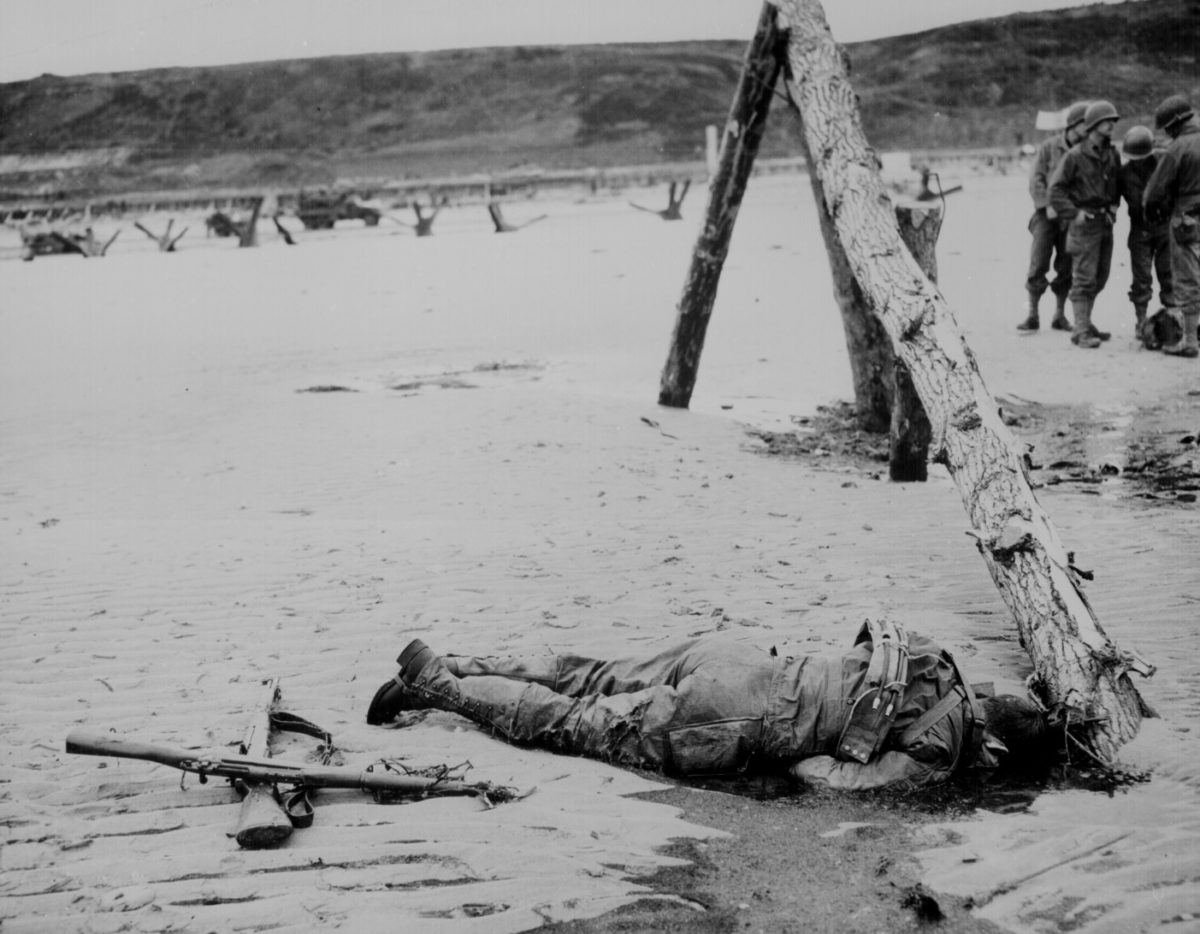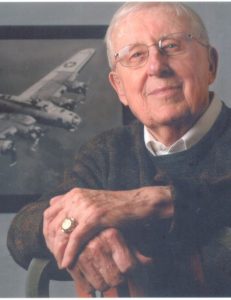[A repost from the 75th anniversary. Yes, the pics are graphic. Look at them. Own them. Be glad they’re in black and white.]





As the 80th anniversary of the launch of Overlord arrives, it’s important to remember that it was just part of a very big picture, the beginning of the end of World War II. Up until that point, it had been a very long, very hard slog. But afterwards you could practically see directly from the beaches of Utah, Omaha, Sword, Juno and Gold on 6-Jun-1944 to the deck of the USS Missouri in Tokyo Bay on 2-Sep-1945. The war now had its expiration date.
No one cheered harder for the faint glimpse of the end than P.o.W.s in Japan, Korea and China. A few of those had survived four years of torture, starvation, beatings, illnesses such as beri-beri and even being bombarded by their own Army Air Force; they were the survivors of Wake Island, which resisted overwhelming Japanese invasion forces between 8-Dec and 23-Dec-1941. Had it not been for Overlord and Manhattan, those men would have died. Instead, they beat the odds thanks to Truman and Ike, Normandy and Trinity. (To quote directly: “Thank God for Harry Truman and thank God for the atom bomb!”)
I always think back to 1989, when as a newspaper reporter, I was privileged to meet just 11 of the Wake Island survivors, who gathered fairly often for small-scale reunions. That year, while working as a reporter who occasionally wrote some features about WWII vets, I got a call from a friend of mine, Marie Smith, (who had kept me sane during my cursed four months while we worked at <shudder> Wal-Mart), to tell me about an upcoming gathering of Wake Island survivors and their wives at the house of her and her husband John. These people were at that point closer than family, bound forever by what happened on a tiny atoll in the middle of a vast ocean.
The article below is what I wrote at the time, but there are two caveats: First, I apparently misspelled some names. I’ve corrected this at the bottom of this post with their bios. And second, this represents nowhere near everything I was told that day. I felt like an eavesdropper, someone who could watch and hear them, but who was so far removed from their time and experience that comprehension was impossible.
In 2016, the daughter of Tony Schawang of Falls City, NE, the man into whose soybeans Braniff 250 fell in 1966, told me an anecdote about her father, who landed on Omaha Beach 75 years ago. She said she once asked him about that day and he said, “Girlie, you don’t need to know anything about that kind of thing.” He was right.
A photographer took Tony’s picture the morning after the Braniff crash. He looks shell-shocked. I could only imagine the horror of seeing 42 dead people and a crashed airliner fall to earth in front of you. But after finding out that Tony had already seen way worse in 1944 made that picture clearer, more understandable. That’s a thousand-yard stare he has in that 1966 photo. I will now always wonder if he was seeing the wreckage of Braniff 250 … or the wreckage of Omaha Beach. Or a bloody mashing together of both. (As much as I respect Mr. Schawang, as the photos above attest, I disagree. We should always know, and see, the consequences of war.)
Now that we’re older, we can understand, and value, more of the meaning and reality of all this, but those Marines and their wives (and Tony Schawang) are now gone. We can’t have conversations with them just because we’re older and wiser and can now listen to them. They’re lost to history … and we’re much the poorer for it.
What do I now know? Don’t put D-Day in service to American (or British) exceptionalism or nationalism or patriotism, and don’t “thank” a veteran for his/her “service.” Man up, grow up and face up to the reality that no one wanted to “serve” us on the cold Normandy sand. They wanted to simply survive. The hard truth is that D-Day (and Wake Island) represented a failure. A failure to confront, contain and eliminate human anger, violence, and hatred in service to nationalistic ideologies in Japan, Germany and Italy. The failure to do that consumed, between 1914 and 1945 upwards of 150 million lives around the world. WWII soldiers HAD to “serve” at Omaha Beach because WE failed to protect THEM.
Instead of “Thank you for your service,” try, “We’re sorry you had to expend your blood, sweat, tears and toil to clean up our monumental failings.” Every time you meet one of the dwindling numbers of WWII veterans (and those of all the other magnificent little American wars we’ve fallen into), keep your mouth shut and your brain focused on peace. These “Greatest Generation” folks answered the bell and won the fight. We might not be as blessed next time.

Here are the original two Wake Island articles:
Memory Of WWII Still Vivid For Vets
(Part I of the Wake Island Story)
‘Considering the power accumulated for the invastion of Wake Island and the meager forces of the defenders, it was one of the most humiliating defeats the Japanese Navy ever suffered.’
—Masatake Okumiya, commander, Japanese Imperial Navy
By Steve Pollock
The Duncan (OK) Banner)
Sunday, August 13, 1989
MARLOW – It all came back to them this weekend – the stark terror of facing death while kneeling naked on a sandy beach the stinking hold of the prison ship; the brutality of the Japanese; the obliteration of youthful innocence.
They fought and bled for a two-and-a-half-square-mile horseshoe of an atoll in the midPacific called Wake Island. They were United States Marines and they did their duty.
There were 10 [sic] men of that Wake Island garrison at the Marlow home of John Smith this weekend. With Smith, they talked, drank and smoked their way through the weekend, laughter masking deeper emotions of brotherhood, camaraderie and painful memories.
In the Smith kitchen, their wives continued the latest of an ongoing series of therapy sessions, attempting to exorcise some of the demons of the last 44 years of their lives with the hometown heroes.
In 1941, with war inevitable, the U.S. government began construction of a series of defensive Pacific Ocean outposts, including Wake, designed to protect against Japanese aggression. They were a little late.
Little Wake atoll, with some 1,616 Marines and civilians huddled on its three islands, was attacked at noon, Dec. 8, 1941, several hours after Pearl Harbor.
The Marines knew war was possible, but “didn’t think the little brown guys had the guts to hit us,” one of them said.
Jess Nowlin’s hearing aid battery is getting a little weak as the afternoon wears on, but his memory and sense of humor are still sharp.
He said the Marines were going about their business when they heard the drone of approaching aircraft.
“We thought they were B- 17’s out of Pearl coming in to refuel. They weren’t. They broke out of a cloud bank at about 1,800 feet, bomb bay doors open. They tore us up,” Nowlin said.
The Japanese attacked from sea and air, but the Marines held out until Dec. 23; only 400 remained to defend 21 miles of shoreline from 25 warships and a fleet of aircraft. Surrender was inevitable.
Through a haze of cigarette smoke, Robert Mac Brown, a veteran not only of World War II, but of Korea and three tours of duty in Vietnam, remembers the post-surrender scene on the beach.
“We were stripped naked and they hog-tied us with our own telephone wire. A squall came through, but lasted only about 10 to 15 minutes. One of my clearest memories of the whole operation is of watching the water run down the bare back of the guy in front of me,” Brown said.
Japanese soldiers lay on the sand in front of the prisoners, swinging machine guns back and forth. The click of rounds being loaded into chambers was ominous. Fingers tightened on triggers.
“There was an argument between the landing force commander and a guy with the fleet. They screamed at each other in Japanese, arguing about whether to kill us or not,” Brown said.
The Marines made their peace and prepared to die.
The argument to make prisoners of the Marines and civilians won the day. The prisoners were allowed to grab what clothing they could to cover themselves.
And then a living hell began which would only be ended by the birth of atomic stars over southern Japan nearly four years later.
Taken off the island on small ships, the prisoners were forced to climb up the side of the Nittamaru, a former cruise ship pitching about on rough seas.
As the men walked back through the ship and down to the hold, the crew beat them with bamboo sticks, in a gauntlet of brutality.
Packed in the stinking hold, several hundred Marines and civilians had only one five-gallon bucket per deck to hold human waste. For the 14 days of the Nittamaru’s passage from Wake to Shanghai, they could barely move.
The cold of Shanghai was felt through their thin tropical khaki. It was January 1942. Robert Brown was to have married his girl on January 12. She married someone else.
“I thought you were dead,” she later told him.
From Shanghai, through Nanking, Peking, Manchuria and Pusan, Korea, the group journeyed in packed cattle cars to their eventual destination, a coal mine on the Japanese island of Hokkaido, where they dug in the shafts alongside third-generation Korean slave labor.
They were slaves themselves until August 1945.
“Thank God for Harry S. Truman and the atomic bomb,” several survivors said, as the others echoed that prayer.
They went home to heroes’ welcomes, but the public ”’never fully appreciated or understood what we did,” Nowlin said.
They’re much older now — in their 60’s and 70’s — and it was a family reunion of sorts; they claim to be closer than brothers. They don’t miss their “get-togethers” for anything in the world; Robert Haidinger traveled from San Diego with a long chest incision after recently undergoing a major operation.
As they gazed through the Oklahoma sunshine, they didn’t see the cow bam beyond the lovegrass rippling in the August breeze; it was a Japanese destroyer was steaming close in to end their lives all over again.
“It was awful, terrible; I wouldn’t have missed it for anything; you couldn’t get me to do it again for a billion dollars,” Nowlin summed it up.
The men: Tony Obre [sic], Fallbrook, Calif; Robert Haidinger, San Diego, Calif.; Robert Murphy, Thermopolis, Wyo.; Dale Milburn [sic], Santa Rosa, Calif.; George McDaniels [sic], Dallas, Texas; Jess Nowlin, Bonham, Texas; Jack Cook, Golden, Colo.; Robert Mac Brown, Phoenix, Ariz.; Jack Williamson, Lawton; Paul Cooper, Marlow, and John Smith, Marlow.
The cost of the defense of Wake Island, from Dec. 8 to 23, 1941: Americans: 46 Marines, 47 civilians, three sailors and 11 airplanes; Japanese: 5,700 men, 11 ships and 29 airplanes.

Wives Cope With Husband’s Memories
(Part II of the Wake Island Story)
By Steve Pollock
The Duncan (OK) Banner
Sunday, August 13, 1989
MARLOW – It all came back to them this weekend – fists lashing out during nightmares, the traumatic memories, the attempts to catch up on lost time.
The wives of 10 Wake Island survivors met in Marlow with their husbands this weekend for reasons of their own.
“We go through therapy every time we get together. We help each other with problems,” they said.
The wives: Florence Haidinger, Maxine Murphy, Opal Milburn [sic], Irene McDaniels [sic], Sarah Nowlin, Betty Cook, Millie Brown, Jo Williamson, Juanita Cooper and Marie Smith.
They did their own bit during World War II: The Red Cross, an airplane factory in Detroit, North American Aviation in El Segundo, Calif, Douglas in Los Angeles, the Kress dime store.
They married their men after the long national nightmare was finished, and their lives became entwined by one event: the Japanese attack on Wake Island Dec. 8-23,1941.
Since the first reunion of Wake survivors and their spouses in 1953, these women have been like sisters.
“We love each other, we’re closer than family,” Jo Williamson said.
In Marie Smith’s kitchen, therapy was doled out in a catharsis of talk little different from that of the men gathered on the patio. Talk is said to be good for the soul; these women heal great tears in theirs every time they see each other.
According to the wives, the men came home from the war, married, had children and tried to pick up where they left off.
They wanted to take care of their families and try to catch up. They were robbed of the fun times of their late teens and early 20’s, the women unanimously agree.
“They have also lived every day as if it were their last,” Sarah Nowlin said.
The men needed some help after their harrowing battle and brutal three -and-a-half-year captivity.
According to the women, doctors never realized therapy was in order: “They never got anything.”
One man lashed out with his fists during nightmares; after a few pops, his wife learned to leave the room. Another would slide out of bed and assume a rigid posture on the floor, arms and legs folded. Yet they have all been gentle men.
“I’ve never seen my husband harm or even verbally abuse anyone,” a wife said Reunions such as this help the men and women deal with life as they age. The youths of 16-22 are now grandfathers and grandmothers in their 60’s and 70’s.
Life today is a bit baffling to them.
Extremely proud of their men, the women have no patience with draft dodgers, flag burners, Japanese cars or foreign ownership of America.
They didn’t agree with the Vietnam war policy, but duty to country should have come first, they said.
“I didn’t want my son to go to Vietnam, but I would have been ashamed of him if he hadn’t,” one said.
The issue of flag burning stirs violent protest and emotion in the group: “Made in America”’ labels are on everything they buy.
And the younger generation does not enjoy the women’s confidence: “I don’t think they could do what we were all called on to do,” they agreed.
And as Marlow afternoon shadows grew longer, the women of Wake continued to cleanse their souls.
Updated bios (confirmed via findagrave.com):
• Cpl. Robert Mac Brown, USMC, Phoenix, AZ.
Birth: 1-Feb-1918.
Death: 21-Sep-2002 (age 84).
Buried: Arlington National Cemetery, Arlington, VA.
• Sgt. Jack Beasom Cook, USMC, Golden, CO.
Birth: 18-Jun-1918, Okmulgee, OK.
Death: 20-Nov-1999 (age 81).
Buried: Fort Logan National Cemetery, Denver, CO.
• Sgt. Paul Carlton Cooper, USMC, Marlow, OK.
Birth: 30-Oct-1918, Richardson, TX.
Death: 18-Sep-1994 (age 75), Marlow, OK.
Buried: Marlow Cemetery, Marlow, OK.
• Cpl. Robert Fernand Haidinger, USMC, San Diego, CA.
Birth: 24-Nov-1918, Chicago, IL.
Death: 7-Mar-2014 (age 95).
Buried: Fort Rosecrans National Cemetery, San Diego, CA.
• PFC Robert Bruce “Bob” Murphy, USMC, Thermopolis, WY.
Birth: 5-Oct-1920, Thermopolis, WY.
Death: 5-Feb-2007 (age 86), Hot Springs County, WY.
Buried: Monument Hill Cemetery, Thermopolis, WY.
• Pvt. Ival Dale Milbourn, USMC, Phoenix, AZ.
Birth: 23-Jul-1922, Saint Joseph, MO.
Death: 18-Dec-2001 (age 79), Mesa, AZ.
Buried: Skylawn Memorial Park, San Mateo, CA.
• PFC George Washington “Dub” McDaniel, Dallas, TX.
Birth: 23-Dec-1915, Stigler, OK.
Death: 14-Jul-1993 (age 77).
Buried: Stigler Cemetery, Stigler, OK.
• PFC Jesse Elmer Nowlin, USMC, Bonham, TX.
Birth: 9-Dec-1915, Leonard, TX.
Death: 13-Sep-1990 (age 74), Bonham, TX.
Buried: Willow Wild Cemetery, Bonham, TX.
• MSgt. Tony Theodule Oubre, USMC (ret.), Fallbrook, CA.
Birth: 17-Aug-1919, Loreauville, Iberia Parish, LA.
Death: 7-Feb-2005 (age 85).
Buried: Riverside National Cemetery, Riverside, CA.
• Pvt. John Clarence Smith, Marlow, OK.
Birth: 11-Mar-1918.
Death: 19-Jan-1994 (age 75).
Buried: Marlow Cemetery, Marlow, OK.
• Sgt. Jack Russell “Rusty” Williamson, Jr., USMC, Lawton, OK.
Birth: 26-Jul-1919, Lawton, OK.
Death: 12-Jul-1996 (age 76).
Buried: Highland Cemetery, Lawton, OK.
The wives (I couldn’t confirm the details for all of them):
• Juanita Belle Sehested Cooper
Birth: 5-Dec-1920, Marlow, OK.
Death: 28-Jul-2001 (age 80), Beaverton, OR.
Buried: Marlow Cemetery, Marlow, OK.
• Florence A Haidinger
Birth: 31-Dec-1934.
Death: 26-Sep-2014 (age 79).
Buried: Fort Rosecrans National Cemetery, San Diego, CA.
• Irene McDaniel
Birth: 24-Nov-1918.
Death: 7-Mar-2004 (age 85).
Buried: Stigler Cemetery, Stigler, OK.
• Maxine Gertrude Gwynn Murphy
Birth: 10-Nov-1923.
Death: 4-Mar-1996 (age 72).
Buried: Monument Hill Cemetery, Thermopolis, WY.
• Marie A. Smith
Birth: 11-Feb-1929.
Death: 16-Nov-1997 (age 68).
Buried: Marlow Cemetery, Marlow, OK.
• Emily Jo Lane Williamson
Birth: 30-Mar-1924, Texas.
Death: 3-Jun-2007 (age 83), Comanche County, OK.
Buried: Sunset Memorial Gardens, Lawton, OK.





